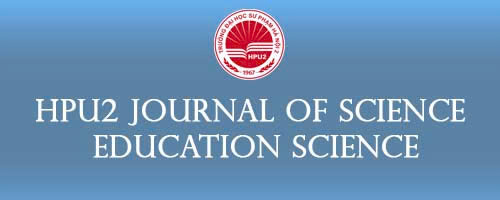A method for growing and differentiating the C2C12 muscle cell line in the laboratory
DOI:
https://doi.org/10.56764/hpu2.jos.2024.3.1.13-19Abstract
Skeletal muscle-related studies have recently been applied in the combat of obesity and metabolic disorders. Culture skeletal muscle cells in in vitro plays an important role in being a promising model for those researches. In the present study, the C2C12 skeletal muscle cells were grown and differentiated in in vitro. The C2C12 myoblasts were grown in Dulbecco’s modified eagle’s medium (DMEM) containing 10% fetal bovine serum (FBS) for 4 – 5 days. The cells then reached confluent about 70% to 100% and the medium was shifted to DMEM plus 2% horse serum which leads the grown C2C12 cells becoming to differentiated myotubes. Myogenin mRNA levels were found to be significantly higher in the differentiated myotubes than those in the growing cells confirming the successful formation of the differentiated C2C12 cells. These results indicate that the C2C12 cell line is suitable for culture in in vitro to mimic a skeletal muscle microenvironment for further investigations.
References
[1] J. W. Gregory, “Prevention of obesity and metabolic syndrome in children,” Front. Endocrinol., vol. 10, p. 669, Oct. 2019, doi: 10.3389/fendo.2019.00669.
[2] E. J. Rhee, “The influence of obesity and metabolic health on vascular health,” Endocrinol. Metab., vol. 37, no. 1, pp. 1–8, Feb. 2022, doi: 10.3803/EnM.2022.101.
[3] U. White, “Adipose tissue expansion in obesity, health, and disease,” Front. Cell Dev. Biol., vol. 11, pp. 1–4, Apr. 2023, doi: 10.3389/fcell.2023.1188844.
[4] N.-H. Le, P.-H. Nguyen, H.-V. T. Ho, D.-T. Chu, “Characteristics of white adipose tissue shape and weight in the restricted high-fat diet-fed mice,” HNUE Journal of Science: Natural Sciences, vol. 63, no. 11, pp. 142–146, Nov. 2018.
[5] J. Tallis, S. Shelley, H. Degens, and C. W. L. Hill, “Age-related skeletal muscle dysfunction is aggravated by obesity: an investigation of contractile function, implications and treatment,” Biomolecules, vol. 11, no. 3, p. 372, Mar. 2021, doi: 10.3390/biom11030372.
[6] L. Chen et al., “Skeletal muscle loss is associated with diabetes in middle-aged and older Chinese men without non-alcoholic fatty liver disease,” World J Diabetes., vol. 12, no. 12, pp. 2119–2129, Dec. 2021, doi: 10.4239/wjd.v12.i12.2119.
[7] C. Hui-Ling, X. Huang, M. Dong, S. Wen, L. Zhou, and X. Yuan, “The association between Sarcopenia and Diabetes: From pathophysiology mechanism to therapeutic strategy,” Diabetes, Metab. Syndr. Obes., vol. 16, pp. 1541–1554, May 2023, doi: 10.2147/DMSO.S410834.
[8] S. Altajar and G. Baffy, “Skeletal muscle dysfunction in the development and progression of nonalcoholic fatty liver disease,” J. Clin. Transl. Hepatol., vol. 8, no. 4, pp. 414–423, Dec. 2020, doi: 10.14218/jcth.2020.00065.
[9] B. Wang, X. Luo, R. Li, Y. Li, and Y. Zhao, “Effect of resistance exercise on insulin sensitivity of skeletal muscle,” World J. Meta-Analysis, vol. 9, no. 2, pp. 101–107, Apr. 2021, doi: 10.13105/wjma.v9.i2.101.
[10] W. Wen et al., “Resveratrol regulates muscle fiber type coversion via miR-22-3p and AMPK/SIRT1/PGC-1α pathway,” J. Nutr. Biochem., vol. 77, p. 108297, Mar. 2020, doi: 10.1016/j.jnutbio.2019.108297
[11] L. L. Tortorella and P. F. Pilch, “C2C12 myocytes lack an insulin-responsive vesicular compartment despite dexamethasone-induced GLUT4 expression,” Am. J. Physiol. Metab., vol. 283, no. 3, pp. E514–E524, Sep. 2002, doi: 10.1152/ajpendo.00092.2002.
[12] M. Dara, V. Razban, M. Mazloomrezaei, M. Ranjbar, M. Nourigorji, and M. Dianatpour, “Dystrophin gene editing by CRISPR/Cas9 system in human skeletal muscle cell line (HSkMC),” Iran. J. Basic Med. Sci., vol. 24, no. 8, pp. 1153–1158, Aug. 2021, doi: 10.22038/IJBMS.2021.54711.12269.
[13] L. T. Denes et al., “Culturing C2C12 myotubes on micromolded gelatin hydrogels accelerates myotube maturation,” Skelet. Muscle., vol. 9, no. 1, p. 17, Jun. 2019, doi: 10.1186/s13395-019-0203-4.
[14] L. Wang, S. Ma, Q. Ding, X. Wang, and Y. Chen, “CRISPR/Cas9-mediated MSTN gene editing induced mitochondrial alterations in C2C12 myoblast cells,” Electron. J. Biotechnol., vol. 40, pp. 30–39, Jul. 2019, doi: 10.1016/j.ejbt.2019.03.009.
[15] L. Jing, "Culture, Differentiation and Transfection of C2C12 Myoblasts," Bio-protocol, vol. 2, no. 10, p. e172, May. 2012, doi: 10.21769/bioprotoc.172.
[16] S. N. Oprescu et al., "Sox 11 is enriched in myogenic progenitors but dispensable for development and regeneration of the skeletal muscle," Skelet. Muscle, vol. 13, no. 1, p. 15, Sep. 2023, doi: 10.1186/s13395-023-00324-0.
[17] Y. Yu et al., "Macrophage polarization in experimental and clinical choroidal neovascularization," Sci. Rep., vol. 6, no. 1, p. 30933, Aug. 2016, doi: 10.1038/srep30933.
[18] C.-P. Segeritz and L. Vallier, “Cell culture: Growing cells as model systems in vitro,” in Basic Science Methods for Clinical Researchers, Academic Press, 2017, ch.9, pp. 151–172, doi: 10.1016/B978-0-12-803077-6.00009-6.
[19] O. K. Uysal, T. S. Sevimli, M. Sevimli, S. Gunes, and A. Eker Sariboyaci, “Cell and tissue culture: The base of biotechnology,” in Omics Technologies and Bio-Engineering, Academic Press, 2018, pp. 391–429, doi: 10.1016/B978-0-12-804659-3.00017-8.
[20] K. H. Kim, J. Qiu, and S. Kuang, “Isolation, culture, and differentiation of primary myoblasts derived from muscle satellite cells,” Bio-Protocol, vol. 10, no. 14, p.e3686, 2020: doi: 10.21769/BioProtoc.3686.
[21] S.-H. Wu, Y.-T. Liao, C.-H. Huang, Y.-C. Chen, E.-R. Chiang, and J.-P. Wang, “Comparison of the Confluence-Initiated neurogenic differentiation tendency of Adipose-Derived and bone Marrow-Derived mesenchymal stem cells,” Biomedicines, vol. 9, no. 11, p. 1503, Oct. 2021, doi: 10.3390/biomedicines9111503.
[22] F. A. M. Abo-Aziza and A. A. Zaki, “The Impact of confluence on bone Marrow Mesenchymal stem (BMMSC) proliferation and osteogenic differentiation,” Int. J. Hematol. stem cell Res., vol. 11, no. 2, pp. 121–132, Apr. 2017, [Online]. Available: http://www.ncbi.nlm.nih.gov/pubmed/28875007.
[23] J. M. Hernández-Hernández, E. G. García-González, C. E. Brun, and M. A. Rudnicki, “The myogenic regulatory factors, determinants of muscle development, cell identity and regeneration,” Semin. Cell Dev. Biol., vol. 72, pp. 10–18, Dec. 2017, doi: 10.1016/j.semcdb.2017.11.010.
[24] E. Meadows, J. H. Cho, J. M. Flynn, and W. H. Klein, “Myogenin regulates a distinct genetic program in adult muscle stem cells,” Dev. Biol., vol. 322, no. 2, pp. 406–414, Oct. 2008, doi: 10.1016/j.ydbio.2008.07.024.
[25] V. Andrés, and K. Walsh, “Myogenin expression, cell cycle withdrawal, and phenotypic differentiation are temporally separable events that precede cell fusion upon myogenesis,” J. Cell Biol., vol. 132, no. 4, pp. 657–66, Feb. 1996, doi: 10.1083/jcb.132.4.657.
Downloads
Published
How to Cite
Volume and Issue
Section
Copyright and License
Copyright (c) 2024 Ngoc - Hoan Le, Dinh-Toi Chu, Rina Yu

This work is licensed under a Creative Commons Attribution-NonCommercial 4.0 International License.







